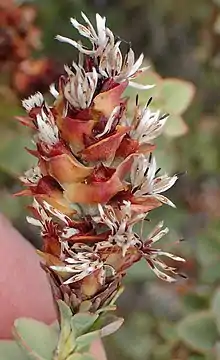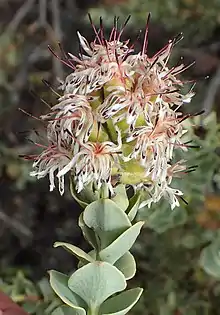| Paranomus roodebergensis | |
|---|---|
 | |
| Scientific classification | |
| Kingdom: | Plantae |
| Clade: | Tracheophytes |
| Clade: | Angiosperms |
| Clade: | Eudicots |
| Order: | Proteales |
| Family: | Proteaceae |
| Genus: | Paranomus |
| Species: | P. roodebergensis |
| Binomial name | |
| Paranomus roodebergensis (Compton) Levyns | |
| Synonyms[2] | |
| |
Paranomus roodebergensis, also known as the honey-scented sceptre, is a flower-bearing shrub that belongs to the genus Paranomus and forms part of the fynbos. The plant is native to the Western Cape, South Africa.
Description

The shrub grows up to 2.5 m (8 ft 2 in) in height and flowers from August to October. Fire destroys the plant but the seeds survive. The plant is bisexual and pollinated by insects. The fruit ripens, two months after flowering, and the seeds fall to the ground where they are spread by ants.
In Afrikaans, it is known as heuningreuksepter. The tree's national number is 72.6.[3]
Distribution and habitat
The plant occurs in the Rooiberg, Huis River Pass, and Touwsberg. It grows in sandstone sand at altitudes of 600–1,300 m (2,000–4,300 ft).
Gallery
References
- ↑ Rebelo, A.G.; Mtshali, H.; von Staden, L. (2020). "Paranomus roodebergensis". IUCN Red List of Threatened Species. IUCN. 2020: e.T113202227A157956224. doi:10.2305/IUCN.UK.2020-3.RLTS.T113202227A157956224.en.
- ↑ "Paranomus roodebergensis". Plants of the World Online. Royal Botanic Gardens, Kew. Retrieved 1 January 2022.
- ↑ "National List of Indigenous Trees in South Africa". 7 January 2019.
External links
 Media related to Paranomus roodebergensis at Wikimedia Commons
Media related to Paranomus roodebergensis at Wikimedia Commons- "Threatened Species Programme | SANBI Red List of South African Plants". redlist.sanbi.org. Retrieved 6 January 2022.
- "Paranomus roodebergensis (Honey-scented sceptre)". biodiversityexplorer.info. Retrieved 6 January 2022.
- "Elongate Sceptres". proteaatlas.org.za. Retrieved 6 January 2022.
This article is issued from Wikipedia. The text is licensed under Creative Commons - Attribution - Sharealike. Additional terms may apply for the media files.



